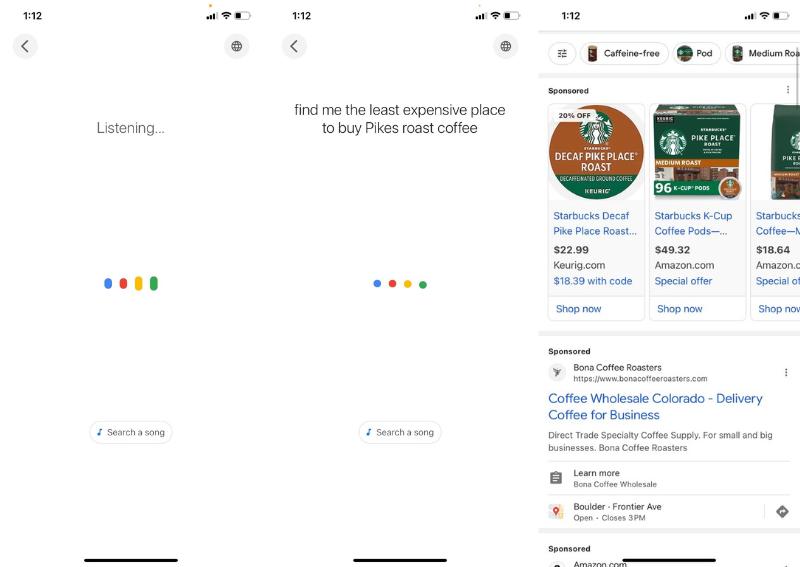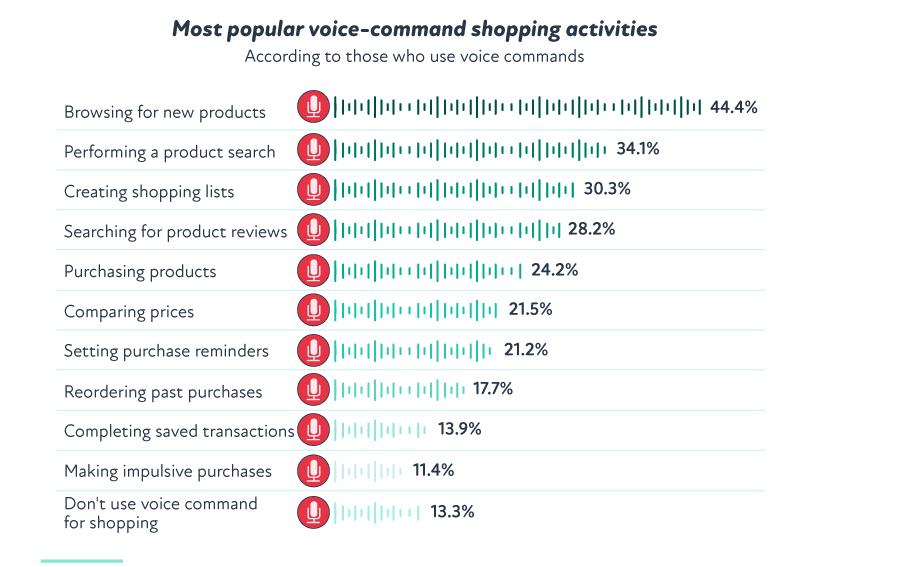Voice commerce is a tool that allows customers to use voice commands to search for products, get answers to questions, and complete transactions. Think Siri and Alexa, but for shopping functionalities.
Voice command technology first came onto the scene in 2012 and has since become much more complex and exploded in use. While we are currently seeing voice commerce being used primarily by major retailers and tech companies, the industry is growing rapidly. You should be prepared for voice commerce to make its way into the small business space in just a few short years.
How Does Voice Commerce Work? (+ Examples)
Essentially, voice command tech uses voice assistance software, artificial intelligence (AI), and natural language processing (NLP) to register, understand, and respond to voice requests. In the case of retail, this means searching for and finding products based on the user’s voice request.
For example, if a customer uses their laptop or phone and asks the voice commerce bot, “Find me long pink dresses,” the bot would take this command, understand it, and provide the customer with a search page of pink dresses. Or, if using a smart home device, the voice commerce bot would guide the user to sites where pink dresses are available.
If you want your ecommerce site to show up in voice commerce searches, you have to be targeting the right keywords on your site. Learn more with our guide to SEO for Ecommerce Websites: The Ultimate Beginner’s Guide.
Let’s take a look at a few real-life examples to get a clearer picture of what voice commerce looks like in action.
Example: Alexa
A voice commerce solution we are probably all familiar with is Alexa, but you may have never used the bot to help with shopping on Amazon. To do so, you simply go to the search bar on the Amazon app and click the microphone icon. Then, your device will ding to indicate it is ready to listen, and you can give your command. From there, you simply ask Alexa for what you need, and she will provide a solution instantly.
In this case, I pulled out my iPhone and asked Alexa to find me pink formal dresses, and she pulled up a search page full of the results I needed, instantly.

Amazon is using Alexa for voice commerce within the Amazon shopping app.
Example: Google Assistant
Another example of voice commerce is Google’s Google Assistant. With Google Assistant, you can voice a shopping request, and it will use the Google search engine to find you all relevant information and results.
Take the example below when I asked Google Assistant to find me the least expensive place to buy Pike Place Roast coffee.

Google Assistant can harness the power of the Google search engine to help customers shop.
Voice Commerce Uses
From the examples above, you might think that voice commerce technology can only be used to find products. While this is one of the primary uses of voice shopping, there are tons of other ways voice-based commerce can help consumers and retailers.
- Create product searches: As we have illustrated, customers can use voice commerce to help them create product searches for product types they want to explore.
- Answer questions: Whether it be product or policy questions, customers can use voice commerce technology to get answers to their shopping questions—instantly.
- Upsell and cross-sell: Your customers can use voice commerce to find complementary products or different items they might want based on what is in their cart.
- Find specific items: If a customer is looking for a specific item, they can use voice commerce to pull it up instantly without having to search for it themselves.
- Place orders: Customers can use voice commerce to complete transactions, from adding the item to their cart all the way through checkout.
- Ecommerce site navigation: Customers can use voice commerce to take them anywhere on your site, from the FAQ forum to a specific product page.
- Manage orders: Shoppers can use voice-based commerce to get order updates, cancel orders, manage returns or exchanges, and track their parcels.
- Find coupons and promos: For extra peace of mind, customers can use voice-activated shopping tools to find available coupons and promos and then add them to their orders.
- Finding product reviews: If a customer wants to see what other people are saying about something they are looking to buy, they can use voice commerce to find product reviews for the item.
- Setting purchase reminders: If an item is out of stock or has a specific drop date, shoppers can use voice commerce to set email or text reminders for when the product is in stock.
- Reordering past purchases: Customers can ask voice commerce to place recurring orders for items they need routinely or to place a duplicate order for something they are buying again.
- Comparing prices: Whether for price matching purposes or to ensure the best deal, people can use voice commerce to compare prices of items they are looking to buy.
- Making and managing shopping lists: You can give voice commerce your shopping list (or create a list with voice commerce itself), and then voice commerce can help you find the items on your list.
Pros & Cons of Voice Commerce
While voice commerce comes with a lot of benefits and can be used to make life better for both you and your customers, there are also some disadvantages that you should take into account.
| PROS | CONS |
|---|---|
| Offer personalized shopping assistance | Many customers prefer people; tech skepticism |
| Works fast | Can hurt customer satisfaction |
| Cost-effective (at scale) | Data security risks |
| Potential to boost sales | Limited functionality can be frustrating |
| Frees up time | Potential alienation of Boomers and GenX |
| Provides reports on user habits | High entry cost |
| Simplifies product search | Implementation on enterprise-level |
| On-the-go solution | Brand dehumanization |
| Attract younger shoppers | Potential for unauthorized purchases |
| Convenient | |
| Available 24/7 | |
Using voice commerce comes with convenience for customers and efficiency for you, but there are some major drawbacks, such as tech skepticism and data security risks. However, customers use voice commerce as a shopping tool, and some of the dehumanizing effects this can have are largely out of your control. The ball comes back into your court when customers enter your individual site.
Overall, voice shopping is convenient for customers and will save your business time, but it can detract from your customer experience and overall trust in your brand. The key is to strike the right balance between automation and human interaction.
At this impasse, it is your opportunity to reintroduce a human element into your customer’s shopping journey. For instance, use a chatbot that offers to connect customers with an agent when they enter the site, feature a warm greeting on your customer homepage, make your contact page easy to find, and offer cookie preference options so customers know their data is safe with you. Do what you can to assuage voice commerce anxieties and build trust between customers and your brand.
Voice Commerce Industry: 2023 & Future Predictions
The technology behind voice commerce has actually been around for over a decade but has taken off rapidly in the past few years largely due to the pandemic. In fact, by the end of 2023, voice assistant ecommerce transaction value is expected to hit $19.4 billion worldwide, a 400% increase from 2021’s ~$5 billion.
Did You Know? In 2022, it was estimated that close to a third of households in the US owned a voice-connected device, like a Google Home or Alexa.
While shopping through voice-enabled technology is newer consumer behavior, customers are very comfortable using voice assistant technology, like Siri and Alexa, more broadly. In a study from UpCity, it was found that 58% of consumers aged 35–24 use voice search daily, and 43% of consumers 55 and older use voice search weekly.
With all the exposure to voice command tech, 78.9% of consumers are very or somewhat likely to use voice command technology for shopping, with men having a slightly higher likelihood at 83.4% than women at 73.9%.
And people already using voice commerce really like it. According to Coupon Follow, around 65% of people walk away satisfied with their voice commerce interactions. You can also take a look at the most common ways people use voice commerce below.

Voice commerce is still working on penetrating the market but it’s most commonly used so far to browse for new products. (Source: Coupon Follow)
Bottom Line
Voice commerce is a retail technology that is growing rapidly among major retailers and tech companies. The trickle-down effect of this is inevitable, and the voice commerce industry is set to grow massively, making its way down to the SMB space in the coming years.
While voice commerce might leave some feeling skeptical, for the most part, consumers are ready to adopt the technology into their shopping experience. With the guide above, you can understand voice commerce, how it works, its uses, and its pros and cons. This understanding will help you better target your ecommerce keywords so you can appear in voice searches and then mitigate user concerns once they are on your site.